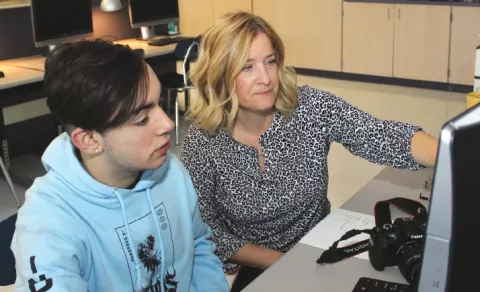Nancy Cogland really didn’t think it would happen again. But in early 2019, there she stood facing the possibility that her job—and those of the other 166 paraeducators in Old Bridge Township, N.J.—could be outsourced to a private company.
The last time they faced this threat, the district’s paraeducators were “caught a little off-guard,” Cogland says. That was eight years earlier, when the school board of this 10,000-student district, saddled with new cuts in state aid and a large budget gap, announced they were considering privatizing paraeducators. With a quick vote scheduled, the board gave them a choice—lose your jobs or give up your family and medical benefits.

“We had no real choice and no warning,” Cogland recalls. “We obviously didn’t want to lose our jobs to a private company, so we agreed to surrender our benefits.”
Luckily, those benefits were reinstituted in the next round of bargaining. But after announcing another round of state cuts in 2018, the school board looked again for savings. Again, the paraeducators’ jobs were on the chopping block.
Many districts already outsource other education support professionals (ESPs), such as bus drivers, school custodians, and cafeteria workers. The focus on paraprofessionals, says Tim Barchak, NEA senior policy analyst, opens up a relatively new front in the privatization fight.
“Everyone is vulnerable now,” he says. “The key is to change the environment in districts to make it more difficult for privatizers to thrive.”
‘PENNY WISE AND POUND FOOLISH’
Mapping the march of school privatization across the United States reveals significant expansion of charter schools and, to a lesser extent, private school voucher programs.
Zoom in closer, and you’ll see a concentration of privatization inside public schools, as more school staff get outsourced.
That is, after all, what privatization is—turning a public good over to a private entity.
Many school districts insist such a move is necessary because they can’t afford pension obligations and health care costs. Or it could also be “plain old opposition of taxpayers to paying more than they would like,” says Samuel Abrams, director of the National Center for the Study of Privatization in Education at Columbia University in New York City.
ESPs are frequently the easiest targets. “Often the specific service they provide is not viewed as core to the mission of educating our students,” Barchak explains. “And these workers are not usually allied with stakeholders in the community,” making it a challenge to build alliances when these threats materialize.
Although not ESPs, substitute teachers (subs) are viewed the same way and are sometimes contracted out to private firms. Substitutes usually don’t need to be licensed educators and are more deeply embedded in the gig economy than any other school job category.
Whoever the specific target, says Abrams, “ultimately, such privatization is penny wise and pound foolish. Privatizing these jobs will mean hiring people with less experience and generating more turnover. This is the opposite of what schools need.”
ON THE CHOPPING BLOCK
Many companies flush with venture capital funds are de- ploying aggressive marketing campaigns, ready to swoop into any district looking to cut costs. Kelly Staffing Services, Swing Education, SPUR, and EduStaff offer enticing—although short-sighted and often misleading—offers of savings, quality, and streamlined efficiency. As for the individual workers, some companies hope to usher them into the flexible world of the “gig economy.” The pitch: Agree to self-privatize and get a hefty one-time boost in salary. Not part of the pitch: Say goodbye to adequate health insurance and pension security.
Substitute teachers are a lucrative market. With growing teacher shortages, schools need quality substitute teachers more than ever. But in many states, subs work without any employee protections or access to health and retirement benefits.
Some subs, such as Greg Burrill, like the flexibility but he belongs to a union and works in Oregon—a state that requires certification. He knows he’s lucky. “Substitutes need protection, especially as more districts farm the service out to private companies,” Burrill says.
Kelly Educational Services has a foothold in many districts, including Shawnee Mission, Kan., where Laura Holland teaches. She has often complained about the quality of the subs being sent to her school. “Generally, they don’t belong in the classroom,” Holland says. “They’re not licensed or prepared. These companies view them as temp workers. That’s a disservice to students.”
‘WE WEREN’T GOING TO STAND FOR IT’
Fortunately, the paraprofessionals in Old Bridge Township had critical structure and relationships in place and persuad- ed the school board to drop its outsourcing plan. They made sure the district knew that any short-term savings were not worth the inevitable decline in quality and accountability.
“The fact is, you get what you pay for,” Cogland says. “We weren’t going to stand for it, and the parents weren’t going to stand for it.”
After the 2011 cutbacks, Cogland had become more involved in her local union, Old Bridge Education Association, and participated in workshops and leadership trainings sponsored by the New Jersey Education Association. By the time the privatization threat reemerged in 2019, Cogland and her colleagues were ready.
All the paraprofessionals in the district work with special education students.
The last time they faced this threat, the district’s paraeducators were “caught a little off-guard…We had no real choice and no warning. We obviously didn’t want to lose our jobs to a private company, so we agreed to surrender our benefits.” —NANCY COGLAND



